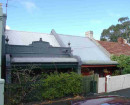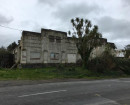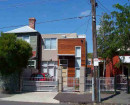Former Hamilton Drill Hall
Milton, McPherson and Francis Streets,Hamilton, SOUTHERN GRAMPIANS SHIRE
-
Add to tour
You must log in to do that.
-
Share
-
Shortlist place
You must log in to do that.
- Download report
Statement of Significance
-
-
Former Hamilton Drill Hall - Physical Description 1
There are only two other drill halls from this period remaining in Victoria, at Colac and Kyneton. Both these buildings are more stylistically interesting than Hamilton. The Hamilton Drill Hall is a very simple, relatively unadorned gabled design framed in timber, clad with galvanised corrugated iron. This was to be a portent of the next era of drill hall design in contrast to the more ornate Colonial drill halls of the late nineteenth century. Hamilton Drill Hall was a precursor to the purely wood and iron drill halls that were built by the Commonwealth after 1912. The building as erected measured 74x30 feet and was supported on concrete foundation stumps as was the stable building. The March 1914 extensions appear to have been restricted to the addition of five small offices in a skillion on the western side to replace offices formerly located in the area of the hall at one end. Internal changes at this time reflected the existing workmanship including the removal of wall vents and their refixing in the new external wall. Internal finishes were restricted to painted, vertical, tongue and groove boards on all walls; the steel roof trusses, with upward curved lower chord and timber rafters and purlins, are exposed below the lower surface of the galvanised iron roof sheeting. The timber framing of the walls is expressed internally in timber mouldings at the junction of walls and roof. Clad externally in vertically placed sheets of galvanised corrugated iron. The building retains the sash windows and doors recorded in the surveys of 1914 and 1941 in addition to carved timber brackets over the rear door canopy.
Site description: The site is of 1.1 hectares bounded by Milton, McPherson and Francis Streets in Hamilton. The east boundary abuts an area of suburban single house subdivision generally dating from the middle of the twentieth century. The Reserve Depot or Drill Hall is situated in the southern corner of the land at the highest point of the property, which slopes to the north west. It is isolated from the general development in the area.Former Hamilton Drill Hall - Historical Australian Themes
Providing administrative structures and authorities - defence
Former Hamilton Drill Hall - Physical Conditions
The building is in good condition. (February 1999) Integrity: The building is intact with respect to the alterations effected over the life of the building. (February 1999)
Former Hamilton Drill Hall - Usage/Former Usage
Defence - 8/7 Royal Victorian Regiment
Veterans Description for Public
Former Hamilton Drill Hall - Veterans Description for Public
The Former Hamilton Drill Hall, on Milton, McPherson and Francis Streets, was designed and constructed Pre - First World War, between 1901 - 1910. From 1901 to c.1910 drill halls such as Hamilton were rented or leased by the Commonwealth in each State. Between January 1910 and October 1913 drill halls were erected to standardised designs or purchased in all states. In Victoria, 12 were under construction with 3 purchased; including the Hamilton Drill Hall.
In August 1914 the first detachment of infantry volunteers and of the Hamilton Light Horse left for training in Melbourne. From 1915 to 1917 the squadron became the 20th (Corangamite) Light Horse and in 1915 the C Company of 72nd Infantry was formed in Hamilton. The Drill Hall was not seen by the community as a centre of the war effort and the honour rolls and memorials were placed in the local hospital, the town hall and at Melville Oval. In the 1920s the squadron was known as B Squadron 4th Light Horse regiment and the Infantry unit was now A Company 21st Battalion. An iron shed at the rear of the site provided stabling for horses. The building and site were modified in 1926 and in 1928; in 1926 new fences and gates were added and in 1928 electricity was installed.
There are only two other drill halls from this period remaining in Victoria, at Colac and Kyneton. Both these buildings are more stylistically interesting than Hamilton. The Hamilton Drill Hall is a very simple, relatively unadorned gabled design framed in timber, clad with galvanised corrugated iron. This was to be a portent of the next era of drill hall design in contrast to the more ornate Colonial drill halls of the late nineteenth century. The Hamilton Drill Hall was a precursor to the purely wood and iron drill halls that were built by the Commonwealth after 1912. The building as erected measured 74 x30 feet and was supported on concrete foundation stumps as was the stable building. The March 1914 extensions appear to have been restricted to the addition of five small offices in a skillion on the western side to replace offices formerly located in the area of the hall at one end.
The impact of the Second World War was slow to reach Hamilton and the major development was the selection of Hamilton in 1940 as the site for a military training camp at the showgrounds, which is near the Drill Hall site and linked by vacant land at that time. In March 1941, the Hamilton Unit of the 9th Battalion of the Volunteer Defence Corps was formed under the charge of R. Dunkley and H.T. Austin. This was a home defence force made up largely of ex-servicemen. Fortnightly drills were held for the 140 or so members, and there were periodic manoeuvres and mock battles. The College Oval is near the site of the Hamilton Army Reserve Depot and the close proximity of the land may have been instrumental in its selection as the site of the Drill Hall. To cater for the larger numbers of troops the firing platform of the former miniature rifle range on the eastern wall of the hall was converted to a kitchen and toilets added at the north-east corner of the hall.
-
-
-
-
-
MECHANICS INSTITUTE
 Victorian Heritage Register H2171
Victorian Heritage Register H2171 -
FORMER HAMILTON TUBERCULOSIS CHALET
 Victorian Heritage Register H1066
Victorian Heritage Register H1066 -
Botanic Gardens Precinct Hamilton
 Southern Grampians Shire
Southern Grampians Shire
-
'Mororo' 13 Oxford Street, Malvern
 Stonnington City
Stonnington City -
1 Arnold Street
 Yarra City
Yarra City -
1 Austin Street
 Yarra City
Yarra City
-
-











